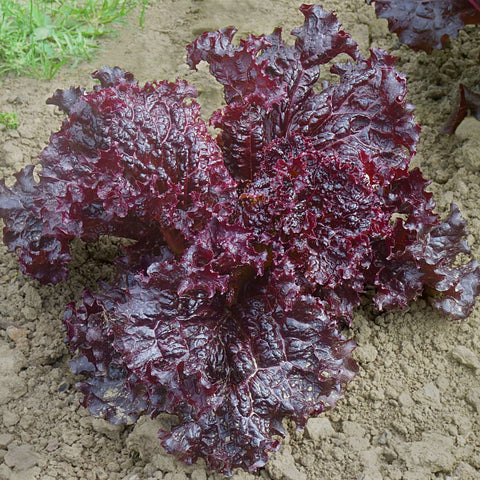

Hortinova
CORALY - Open Pollinated Batavia Lettuce Seeds
Lactuca sativa
- Mid-early maturity.
- Batavia lettuce type.
- Deep red colored leaves.
- Improvement of “American Brown”.
- Bremia resistance: 1-16 ; 18-25.
- Open-pollinated seeds.
- Natural, Untreated, Non-GMO Seeds.
Always use fresh seed because old lettuce seed is unlikely to germinate well. Make small successional sowings every 2-3 weeks for continuous crops. Sow directly into the soil from early spring to midsummer by creating a shallow trench about ½ in (1 cm) deep using a cane. Sprinkle seeds thinly along the bottom of the trench, label the row, and cover seeds with soil. Water thoroughly using a watering can fitted with a rose. Space rows 6 in (15 cm) apart for smaller varieties and 12 in (30 cm) apart for larger headed lettuces. Seeds may not germinate well in hot weather, so make summer sowings in a lightly shaded spot or during the cool of the evening.
THIN: Thin seedlings out to their final spacing along the row when they are about 2 in (5 cm) tall: spacings vary from 6 to 12 in (15 to 30 cm) depending on the variety. Remove unwanted plants with your fingers and add them to salads as delicious baby leaves.
WATER: Water the soil around the plants regularly during dry weather and as they mature. Avoid splashing the leaves; this can cause problems with scorch or fungal diseases.
PROTECT: Create traps and barriers to prevent slugs and snails from destroying seedlings. Check the crops at night with a torch and remove any pests. Cover lettuces with cloches in early spring and fall to protect them from cold and extend the growing season. Grow winter lettuces in an unheated greenhouse.
There's more than one way to pick a lettuce. Both headed and loose-leaf varieties can be cut when mature by using a sharp knife to slice through their stem at soil level. Loose-leaf varieties can be harvested gradually by picking just a few outer leaves from each plant as required. This makes more efficient use of space, as plants will crop over several weeks. Leaves are best eaten freshly picked but can be stored for a short time in the fridge in a sealed plastic bag.
Let customers speak for us
from 23 reviewsWe grow several varieties of various colours of tomatoes, and the contrast of these tomatoes with other colours is fantastic. We've had a very long season with our plants, excellent disease resistance, great flavour.

This review applies to all of the seeds I purchased from Hortinova - beautiful tomatoes, good disease resistance and excellent production. Our field season extended to 10 weeks. We've had comments of excellent flavour from our customers as well, highly recommend any Hortinova seed.

This tomato is good taste tomato. Small red round tomato. Bigger then cherry tomatoes but smaller then regular one. I like it. Perfect for salads and fresh eating. Ordered seeds for next season.

2nd time ordering. Very satisfied with qualify and result. Thank you

BALCONY YELLOW F1 - Hybrid Cherry Tomato Seeds

Delivered very fast, packed very good, in professional condition and quality. Thanks

DUETT - Open Pollinated Radish Seeds

We will see what they are like this summer.

Type crimson de bonne grosseur avec une superbe uniformité et très hâtif. Un des premiers prêt en saison. Semences très petites et peu nombreuses. Goût très sucré et chaire croquante. Chair passant du rose au rouge en cours de saison. Les plants sont forts et très vigoureux avec des grosses feuilles.

Vigueur des plants impressionante avec des fruits résistants aux fissures et aux dommages. Très bonne conservartion et goût très sucré lorsque les nervures deviennent orange. Peu être récolté lorsque les nervures sont vertes également. Cavité des semences très compacte et petite laissant beaucoup de chair.

Melon qui fond en boûche avec un goût se rapprochant du melon miel et du cantaloup à la fois, très sucré. Faire attention aux irriguations lorsque le melon devient mature car il peut fendre au champs. Très odorant.

Avec son apparence côtellée, son très gros calibre et ça couleur rose, cette tomate se démarque des autres sur les tablettes. Variété plus résistante à la pourriture apicale que la plus part des autres tomates roses. Bon ensemble de résitance aux maladies également.

Tomate noire dont les faces qui ne sont pas exposé au soleil passent du vert au rouge lorsque mature donnant un aspect unique aux fruits. Charactéristiques similaires à la Barrio avec un goût superbe sans acide. Les clients l'on adoré.

Superbe adaptabilité et excellente résistance aux maladies. Fruits uniformes qui ne fendent pas, bonne conservation. Ajoutez à cela un goût unique avec une légère acidité et une pointe sucré.















